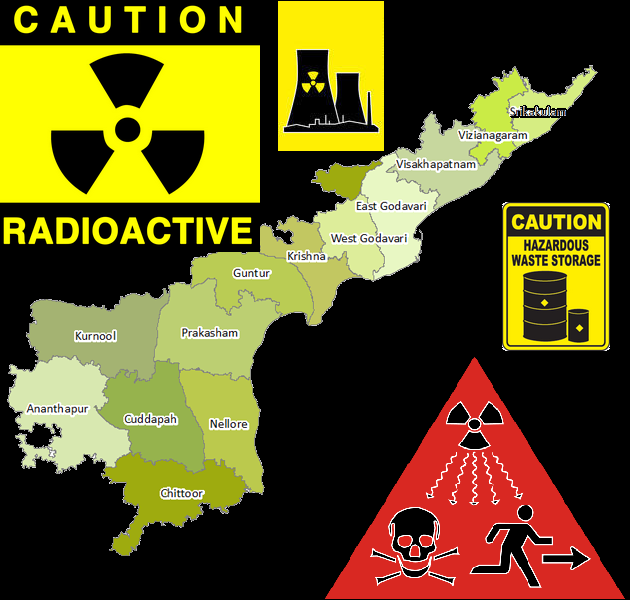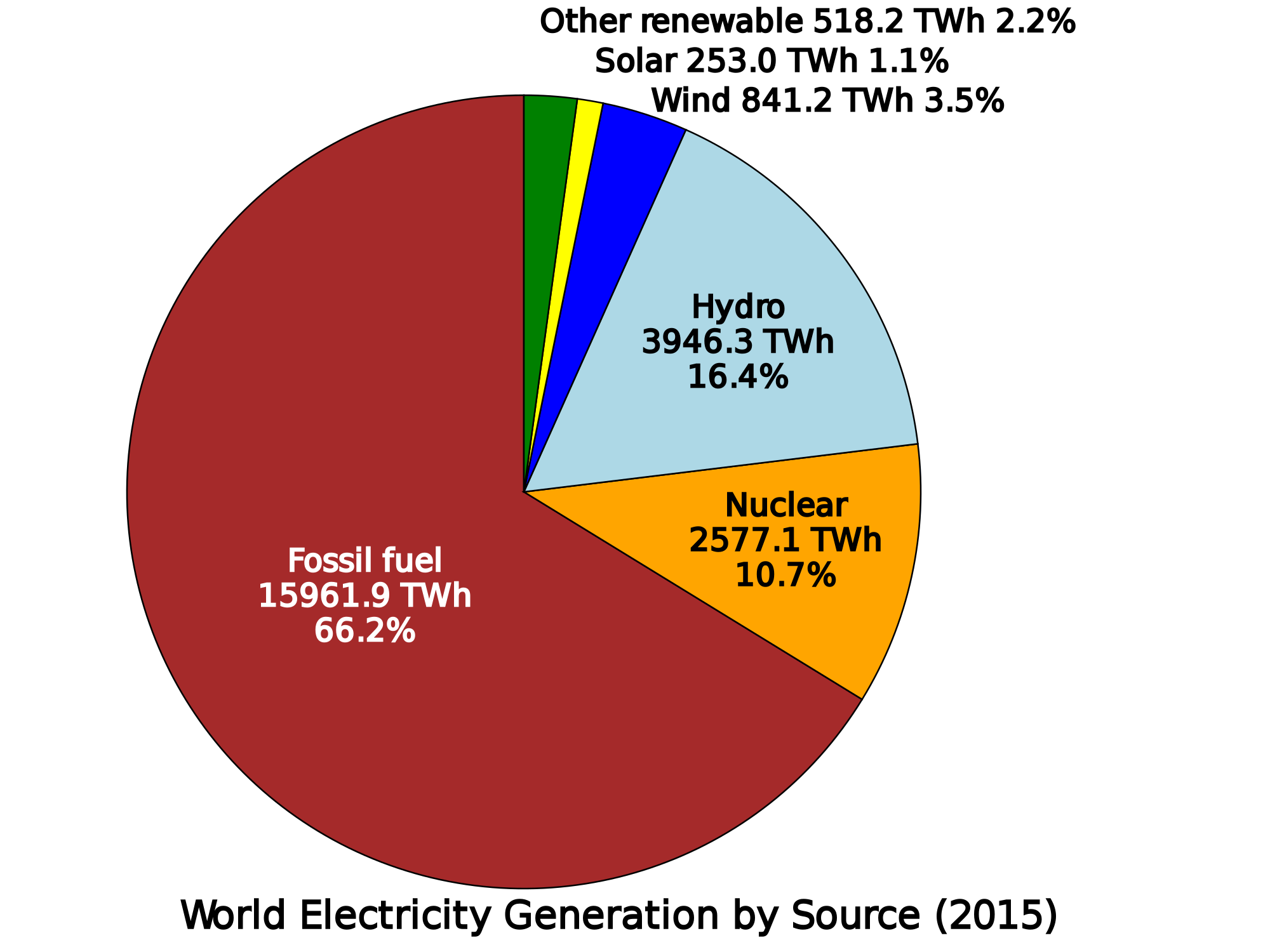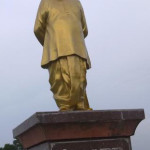A BOLT FROM THE BLUE
‘Andhra Pradesh set to become a nuclear power hub,’ the headline of a report in The Hindu dated July 21, 2016, says. It quotes a central minister as saying, ‘In Andhra Pradesh six nuclear centres are going to be created, totalling thousands of megawatts capacity.’ As against the government’s goal of 53,000 MW installed capacity by 2031, AP will account for 30,000 MW.’
One is free to feel elated and take the ‘bonanza’ granted to AP as solely out of immense love of the Centre. One is also free to feel that Andhra Pradesh is playing host to so many nuclear reactors at its own peril. The states of Gujarat, West Bengal, Tamil Nadu and Maharashtra are not so hospitable as AP, in the teeth of uprising of their people. Two of the centres proposed in AP are by transfer one each from West Bengal and Gujarat.
Interestingly, in Gujarat, besides the opposing people, the Tatas, the Adanis and Essar are not ‘comfortable’ with the gigantic plant proposed as they are owners of power plants there. What a euphemistic word to be used by the paper—not feel comfortable; instead of the word opposed. Some people of AP at the proposed locations may at best be ‘feeling uncomfortable,’ not more than that yet. Are they fatalistic or are so pragmatic that they are not prepared to break their heads against a stone wall? Even at Kovvada in Srikakulam district the people seem to be giving up their struggle of years. What is the tactic of governments? They wait to the extent possible and tire out the people whose struggle in opposition is intense. Then the poor and fatigued people, who are fatalistic basically, can be lured into accepting packages by making them appear attractive to their eyes—offers they cannot refuse.
Is it coincidental or paradoxical or both that at a time when the global nuclear industry is in doldrums and the global share of nuclear power has fallen from its historic peak of 17.6 to 10.7 per cent in 2015, the proposal to make AP a nuclear hub has come about? One thing, however, could perhaps be said. For nothing in return those in governments take such major decisions, which have far reaching consequences, in the name of national interest. Who decides which is in national interest and which is not? Not the people, but the governments which are not afraid of the people except in an election time. India does not have a history of the people of an entire state taking up cudgels against setting up nuclear plants; those who are away from a site chosen feel comfortable of the fact that, after all, it is not going to happen in their own frontyards or backyards. In a selfish world why should one bother oneself by taking a holistic attitude and contracting others’ headaches?
In the backdrop of the government’s decision, those who are going to live in the company of so many nuclear reactors—just in one state—in their neighborhood need to know some basic facts concerning nuclear energy with a historical perspective. The safety of generation after generation to come over thousands of years is now at stake. Let us question ourselves as to what moral right we have to drag future generations into dangers by a step the present generation takes. Once the people in the state of AP know enough of the issues involved and what they entail to them, it is up to them whether to take to a path of agitation or to resign themselves to the potential dangers. But how will they know, in the first place? It is not just an issue of displacement of people, more serious concerns are involved in the proposal. What is happening in reality? Once the displacement issue is taken care of nuclear concerns are ignored by the people.
Nothing new is going to be attempted here other than giving an account of the facts which already are in the public domain as results of brainstorming by those who are far better qualified than me. I want to re-echo them in prapancha hitam—by a ‘collection’, beelike, from various sources. This honey is bitter unlike its sweet cousin; but both intend to do good. This is a layman’s narrative for laymen’s sake. There is no guarantee against a feeling of already being familiar with these facts, while going through them—except that it is worthwhile.

Proposed Andhra Pradesh Nuclear Power Projects in 2016
$ – Rosatom is likely to build 6 power plants in the state. Srikakulam & Nellore Districts among the locations.
$ – 1 Russian nuclear power project to build 6 VVER reactors in Haripur, West Bengal is likely to be moved to Andhra Pradesh due to protests by locals.
$ – Westinghouse Electric announced that it will be relocating 1 proposed project to build 6 nuclear reactors from Mithi Vardi in Gujarat to Andhra Pradesh.
$ – GE-Hitachi: allocated a site in Andhra Pradesh to build 6 Economic Simplified Boiling Water Reactors. the project has been put on hold as India is wary of GE- Hitachi nuclear reactors as they have not been tested before.
$ – “if everything goes according to plan, Andhra Pradesh will be home to more than a dozen nuclear reactors.” [3]
~18 Reactors and ~9 Nuclear Plants to be constructed in Andhra Pradesh
THEIR NUCLEAR LOVE IS NOT BLIND
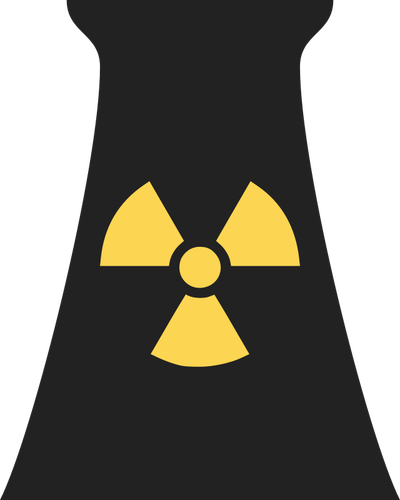
The nuclear issue goes beyond the need of energy security, defence and foreign policy points and there’s the rub.
Dr Anil Kakodkar, former head of the Department of Atomic Energy, said in a Marathi article that India must import reactors with billions of dollars because, “We also have to keep in mind the commercial interests of foreign countries and of corporates there.” That preposterous altruism should be read in conjunction with what Dr A. Gopalakrishnan, a past chairman of the Atomic Energy Regulatory Board, said in his article of DNA dated March 17, 2011: “Even in the negotiations of costs, the safety and liability of imported reactors, the official nuclear agencies today are operating hand-in-glove with their friends in the corporate houses and federations.” He further says, “Ever since the UPA government has taken over in 2004, the collusion between the PMO, DAE, NPCIL and the various corporate houses in India and abroad has substantively increased.” In the wake of the nuclear deal with the US which would pave the way to the lifting of international nuclear embargo on India, the UPA government had to face a no-trust motion in Parliament.
To save itself it bribed some Members of Parliament by paying Rs.10 crore each involving a total amount of Rs.50 to 60 crores as revealed by Wikileaks. The US embassy at that time informed Washington that the Congress party officials boasted that they would buy opposition MPs to win the trust vote. Why was even the continuation of the government risked on the nuclear issue and corrupt practices resorted to if the intentions were bona fide? If one argues that in the national interest it will not be bad even if dubious means are adopted, that will be a different case. In an article dated at countercurrents.org, Dr Kakodkar is quoted by Capt Buddhi Kota Subbarao, PhD, as saying: “America, Russia and France the countries that we made mediators in the efforts to lift sanctions, and hence, for the nurturing of their business interests, we made deals with them for nuclear projects.” A quid pro quo shamelessly admitted to have been made.
Capt (Dr) Subbarao debunks the conception that nuclear power plants are needed to make nuclear weapons. The plutonium that was used in Pokhran I [1974] and Pokhran II [1998] nuclear tests was derived not from nuclear power reactors but from the Research Reactors.

The nuclear power industry indulges in a strong public relations campaign and it is backed by powerful lobbying groups. When the Three Mile (TMI) accident occurred the whole official establishment and nuclear industry moved in a coordinated manner and were in a denial mode about the ill effects. Some dubbed the effort as “one of the biggest lies ever in American industrial history is that no one died at the Three Mile Island.” Dr John William Gofman, who was instrumental in developing the atomic bomb, had as a medical doctor to his credit breakthrough discoveries in heart diseases and LDL/HDL cholesterol. He was chief of health research at the Atomic Energy Commission. When he came up with findings nailing the lie of the establishment he was promptly fired. He discovered that regular radioactive emissions from America’s nuclear plants would kill 30,000 citizens per year even without an accident or terror attack. He refused to change his findings when the industry tried to prevail upon him. He preferred to lose his job.
The Radiation and Public Health Project which tried to reveal horrifying truths of the TMI was branded as of little credibility even by the community of scientists. Joseph Mangano, one of its members, who has a master’s degree in public health, was not surprised by the opposition he faced from the ‘military-industrial-energy-pharmaceutical-governmental complex.’ He ran the shoe-string organisation with offices mostly on his kitchen table that spent several years questioning the safety of nuclear power stations. He came up with the finding that the nation’s 100-plus nuclear power reactors when operated under normal conditions were giving people cancer.
Harvey Wasserman, who edits newsfree.org and is a senior editor of freepress.org, in an article in commondreams.org, dated November 19, 2007, observes, “Today, with billions in bailout dollars on the line, there is big money to be made in saying that atomic reactors have harmed no one.”
The country also seems to feel with a touch of quaintness that by doing nuclear business with other countries it can win friends who can come to its aid in international affairs. Add to that the ambitions of the leaders at the helm who hanker after their personal international image. The costs involved in winning such friendships and image-building are not amenable to estimation—colossal the costs are.
THY NAME IS HYPOCRISY
American companies have been building nuclear reactors in other countries. Even after 37 years of the accident at the Three Mile Island it is not yet ready to give a chance to new nuclear energy plants. For the US, selling of just two reactors means thousands of jobs. Barack Obama, who promotes nuclear power deals with other countries, during the course of a speech said that every four minutes another American house or business goes solar.
The French utility Areva, having almost gone bankrupt, scouts for nuclear business. The country plans to reduce its nuclear-generating capacity by a third by 2025 one of the reasons being prohibitive costs of reactors. Where a rich France does not dare, India tries to tread.
Australia possesses over 40 per cent of the world’s uranium reserves, but it does not dare or care to generate nuclear power.
Russia which is still battling the Chernobyl-disaster cleanup is aggressively pushing for its nuclear trade with other countries.
No nuclear company is prepared to bear any liability to its full extent. They know by experience how huge the costs of liability could be and how accident-prone the reactors are. India is foolhardy to limit the liability of foreign suppliers to just Rs.1500 cr. One major nuclear accident is enough to leave its entire economy in dumps. In the aftermath of the Fukushima disaster Japan is estimated to have incurred anywhere between $150 to 250 billions so far, probably a half of which is towards compensation.
Austria, Sweden, the Netherlands, Belgium and Germany have decided to freeze or phase out nuclear power.
CLEAN LIKE THE GANGA
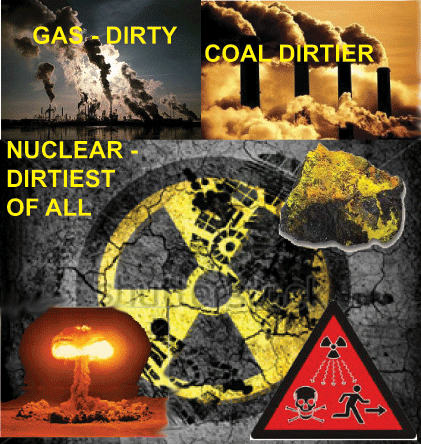
Maybe nuclear generation by itself is clean, but the same cannot be said of nuclear fuel cycles. They are carbon-emitting. Greenhouse gases are generated during mining and enriching uranium. The construction of a reactor bears large carbon footprints. The proponents of nuclear power highlight the front-end as emission-free, conveniently downplaying the back-end dirtiness. Therefore any claim that nuclear-power generation is clean needs to be taken with a pinch of uranium.
NUCLEAR ENERGY IS CHEAP LIKE PEANUTS
The 6 Kovvada nuclear reactors are estimated to cost Rs.4,00,000 crores. One reactor costs around Rs.65,000 cr. The facts that (a) the plants require the highest capital in the energy sector, (b) they are the highest water guzzlers and (c) they have the highest gestation period of over 10 years among other energies belie the claim that nuclear energy is cheap. Some have put the cost of nuclear energy at Rs.48 cr per megawatt which may not be an exaggeration. To say it is ‘too cheap to meter’ is a big falsehood.
NO RISK—AS TRUE AS THE HARE HAVING A HORN
Experts say that in a nuclear power plant the risk can only be lowered but not eliminated. The work of a nuclear plant is extremely complex and it is next to impossible to predict all possible failures. To err is human. You cannot eliminate a human error, unless those involved in the process are superhuman, either in designing or in operation of a plant. There are multiple ways in which accidents could sneak in. If you try to fix one it will give rise to another. In Fukushima while tsunami and earthquake were hand in hand externally, the Three Mile Island and Chernobyl accidents had internal causes.
A study lists 99 nuclear accidents which could cause at least one death or a damage costing above $50,000. India accounts for 7 of them. Besides those, Kakrapur Atomic Power Station in Gujarat on March 11, 2016 suffered a leak of heavy water. The newly commissioned Kudankulam also had a leak.
THREE MAJOR ACCIDENTS AND THE SINGLE LESSON THEY TAUGHT

The US, the only country which exploded a bomb in anger, also has the dubious distinction of having the first major nuclear accident too in its nuclear plant at Three Mile Island on March 28, 1979. A combination of personnel error, design deficiencies, and component failures caused it. As robot cameras revealed one third of the fuel melted. Then no one knew what was really happening as it was unprecedented. Even after 37 years, the decommissioning of the plant and restoration of the site are decades away. Plans are afoot to fully restore the site by 2054—75 years after the happening. They claimed there were no immediate deaths or injuries and that its long-term impact would be negligible. They however admit that the psychological toll was immense.
Though the TMI’s owner claimed that its releases harmed no one, the Nuclear Regulatory Commission admitted to Congress that nobody knew how much radiation escaped or where it went. Official figures showed a huge jump in infant death rates in Hartsburg in the three months after the accident. Compared with the numbers for the previous two years State’s statistics showing heightened cancer rates were quickly altered. An investigative team from the Baltimore News-Herald uncovered a massive epidemic of death and disease among the area’s farm and wild animals. The writers, based on a horrifying series of house-to-house interviews, found cancer, heart attacks, respiratory problems, skin lesions, cataracts, a metallic taste in the mouth, hair loss, etc.
Not many years later, on April 26, 1986, the worst of the three major accidents happened at Chernobyl in Ukraine as a result of an experiment carried out by the plant personnel, besides there being construction errors and negligence. According to a calculation of Dr Alexey Yablokov, a member of the Russian Academy of Sciences, as reported by Common Dreams dated March, 25 2011, one million people died. He rued that his book ‘Chernobyl: Consequences of the Catastrophe for People and the Environment,” which he co-authored, had been met mainly with silence from bodies like the World Health Organisation and no discussion took place about the findings he pointed out in the area around Chernobyl, as contaminated today as it was 25 years ago. Cesium, americium, strontium and plutonium that got deposited in the soil have reached the roots of plants which then propel the radioactivity back to the surface.

John Vidal in his article, ‘Nuclear green Cheerleaders forget Chernobyl at our peril,’ published in The Guardian dated April 1, 2011, says when he went from hospital to hospital in the still highly contaminated areas of Ukraine and the Belarus border in 2006, after 20 years of the accident, they found deformed and genetically mutilated bodies in the wards; pitifully sick children in homes; adolescents with stunted growth and dwarf torsos; fetuses without thighs or fingers and villagers who told that every member of their families was sick. They heard of many unusual clusters of people with rare bone cancers. One doctor in tears told them that one in three pregnancies in some places were affected and that she was overwhelmed by people with immune and endocrine system disorders. Others said they still saw cesium strontium in the breast milk of mothers living far from the areas thought to be more affected, and significant radiation still existed in the food chain. Villagers testified that the ‘Chernobyl necklace’—thyroid cancer—was so common as to be unremarkable; many showed signs of accelerated ageing. The article further reports that Konstantin Tatuyan, one of the liquidators, who had helped clean up the plant, told them that nearly all his colleagues had died or had cancers of one sort or another. The radiation released at Chernobyl was estimated to have far exceeded the one at Hiroshima and Nagasaki.

When the disaster at Fukushima happened on March 11, 2011, even the Japanese Prime Minister was panicky. In his testimony before the Parliamentary Committee he said, “There wasn’t much information coming to me from the government regulatory agency, NISA, or the Plant’s Operator, TEPCO. I thought I couldn’t make any counter-measures in this crisis. I felt fear.” He condemned the utilities, nuclear regulators, bureaucrats and academics who support the legacy of nuclear energy in Japan. This group [termed as ‘nuclear village’] he felt had no remorse for the disaster.

The accident resulted in a massive radioactive contamination of Japan’s mainland. Long-lived radioactive cesium contaminated 30,000 sq km of the land surface. Some 4,500 sq miles was found to have radiation levels that exceeded Japan’s allowable exposure rate. Even after 5 years since the accident, road to recovery has been difficult and long and is not yet complete. It took the government 88 days to accept that a meltdown had taken place. TEPCO [Tokyo Electric Power Company] estimates that the cleanup operations could take up to 40 years.
A Japanese Greenpeace campaigner says, “There is still an enormous amount of radioactivity there which is not controlled, in liquid form, leaking into the underground, and slowly moving into the ocean and that is very dangerous for the future”. Everyday, 300 tons of contaminated water leaks from the crippled nuclear plant. About 3 lakh people lived in the neighbourhood of the accident. Five years after the happening, tens of thousands still live in temporary housing.
WASTE OR MONSTER
Frankenstein faced the wrath of the Adam of his own labour. Having learnt a lesson from what he did he became wiser and refused to create a female monster-mate for the male one to live with. Indians have their own Bhasmaura who chased Siva to save whom Vishnu had to take the trouble of incarnating as Mohini. Our ‘civilised nations’ refuse to learn lessons of their misadventures. They create nuclear waste and they are at their wits’ end on how it can be disposed of. A human lives only a hundred years; the monster is ageless and deathless. If we fail to keep it in proper chains it will devour us. But a tragedy is that you can’t hold it in chains however strong they may be for long. He chaining is just an act of postponing its going on a rampage.
The waste has to be kept in large water pools for cooling down which may take 1 to 10 years and then transferred into caskets [steel cylinders surrounded by additional steel or concrete]. Mind you, nuclear waste can be only stored, not made to disappear. A decommissioned reactor poses as serious a problem as the waste it has generated. Everything in life perishes except nuclear waste. Just imagine how it would be possible to store a huge quantum of waste the 546 reactors generate worldwide.
The Bush administration in 2002 chose Yucca Mountain in Nevada as a common repository for geologic isolation of 70,000 metric tons of its total waste of 107,000 mt and spent on the project $12 billion dollars. The consolidated geological repository was intended to isolate the waste to protect future generations over a period of 250,000 years—which also means that it has the potential to harm for so long a period. The Department of Energy admitted that there was no guarantee that the radioactive waste would not leak into the ground water some day. If it so happens, it would affect potable water, meat grown with the contaminated water, and milk from cows which are exposed to the contamination through their feed and water. The ground water-table could rise and come in contact with the waste. Even the storage containers are prone to breaking open. There also was the possibility of portions of the mountain collapsing. The people were naturally aghast and opposed the move. The Obama administration, as promised at his election time, stopped funding which led to mothballing the project.
What do you expect from democratically elected governments? They should bow to public opinion. But even in countries which wear on their sleeves their democratic credentials, when it comes to nuclear issues, bitter is the experience. There can however be exceptions always. The headline of the BBC News dated May 30, 2011, sounds musical to the ears of those who value human life and public opinion: “Germany: Nuclear power plants to close down by 2022.” Incredible? Germany took a decision to phase out all its nuclear plants by 2022 yielding to massive public protests post the Fukushima disaster. As a first step it decided not to reuse its seven oldest reactors which were taken off line for a safety review. One more would be offline due to some technical glitches and six other ones would go offline by 2021. This was despite the fact that one-fourth of Germany’s energy need is met by nuclear power sector.
DO WE HAVE ONLY HOBSON’S CHOICE IN OPTING FOR NUCLEAR POWER? RUBBISH!

Climate temperatures are attributable to variations in carbon dioxide in the atmosphere. It is an important heat-trapping [greenhouse] gas, which is released through human activities such as deforestation and burning fossil fuels as well as a natural procedure such as respiration, volcano eruptions. If climate changes sea levels rise and oceans become warmer. Longer and more intense draughts threaten crops, wildlife and fresh water supplies. The planet’s diversity of life will be at risk. It affects peoples’ livelihoods, places and species. So if we do not want ourselves to perish we have to cut down on carbon emissions. This is possible only by opting for clean, cheap, renewable and harmless energy. Are we then left with only the option of going nuclear? We already know its perils. We are using nuclear energy to supplement our energy basket of renewables such as wind and solar. A simple question is: What prevents us from investing more in the renewables and obviate the necessity of the nuclear option? An equally simple answer: Nothing prevents us if we have the will. Three major renewable resources are sun, water and wind with various other sources which can chip in handsomely. As Capt (Dr) Subbarao observes India would reap enormous harm by largely investing in nuclear energy which starves funds for other sources of power.
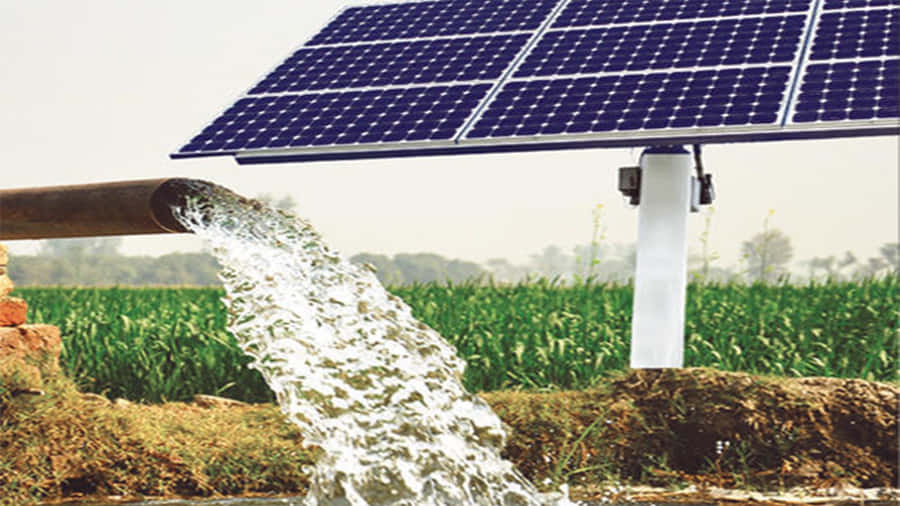
We revere the sun as a god and chant the Gayatri Mantram for both spiritual and earthly well-being. The sun never grudges our drawing more and more energy from its shine [it in fact shines for our sake]. But take enough care even from a god and do not over-expose yourselves to its radiation. It allows us to make hay while it shines. Means are being found to store such hay and use it even when it does not shine, especially during nights. As per a cnn.com report dated October 3, 2011, unlike a typical solar power plant which stops working when the sun sets, a new one in southern Spain, called ‘Gemasolar’ can supply power all through the night. During the day it captures the energy of the sun and stores it in a tank. Then, regardless of day or night it can be converted into electricity. Located outside a village Fuentes de Analucia, ‘Gemasolar’ bills itself as the world’s first commercial-scale concentrated power plant that uses molten salts receiver technology. 2,650 large mirrors called heliostats direct the sun’s rays to a receiver at the top of Gemasolar’s 450-foot tower that shines like a beacon during the day.
The Hindu dated October, 4, 2012, quotes a study according to which India can meet its energy needs sans nuclear power. The study of two professors from the Indian Institute of Science, Bangalore, published in ‘Current Science’ says 4.1 per cent of the total uncultivable and wasteland area in India is enough to meet the projected amount of annual demand of 3,400 TWh by 2070 by solar energy alone. Even that extent of land could be reduced to 3.11 per cent if other potential renewable could be tapped. The newspaper also quoted another IISc professor as saying that a three kilowatt rooftop solar panel system on the 425 million Indian households can generate total per-year energy of 1900 TWh and meet half the demand projected by 2070.
Wind never stops from blowing. We have read about some yogis substituting air for food. If we all could emulate them we can solve the problem of hunger in the world. Paradoxically quite nearby the Kudankulam nuclear plant, thousands of windmills are rotating generating wind power. The potential of wind energy in India is estimated at 20 to 30 times more than the government’s assessment of over a lakh of megawatts. In come parts of the country the cost of wind power dropped below than of coal-based energy. Wind power can increase to 20 per cent worldwide by 2050.
Hydro and waste-to-energy are other renewable sources of energy. According to an estimate 75 per cent of hydro potential is yet to be exploited. Oh, our potential to produce waste is limitless! It has plenty of potential to generate electricity. Once a stage is reached when not a kilo of waste is not wasted, we may cease to call waste as waste. Bio-mass, bio-gas [sewage, landfills and livestock] could come in handy. Andhra Pradesh being a coastal state is ideal for Tidal power plants.
The World Nuclear Industry Status Report dated July 13, 2016, makes an interesting reading:
- Compared with 1977, when the Kyoto protocol on climate change was signed, in 2015 an additional 829 TWh wind power was produced globally and 252 TWh of solar photovoltaic electricity, compared to Nuclei’s additional power of 178 TWh.
- In 2015, power generation using Solar energy grew 33 per cent, wind power over 17 per cent, and 1.3 per cent from nuclear source, entirely due to 31 per cent increase in China.
- China spent over $100 billion on renewables in 2015. While investment decisions for 6 nuclear reactors amount to $18 billion.
- Share in energy-mix: The nuclear share of the world’s power generated remains stable over the last four years, with 10.7 per cent in 2015 after falling steadily from the historic peak of 17.6 per cent in 1996.
The Guardian dated May 9, 2011, reports that the Inter-Governmental Panel on Climate Change [IGPCC], the body of the world’s leading climate scientists, convened by the United Nations, says that if the full range of renewable energy technologies are deployed, the world could keep greenhouse gas concentrates to less than 450 parts per million, the level scientists have projected will be the limit of safety beyond which climate change becomes catastrophic and irreversible. Investment in renewables to the extent needed would cost only about 1.1 per cent of global GDP annually.

SOME BASIC STUFF
- An atom is the smallest particle that can break a material. Nuclear energy is the energy in the nucleus of an atom. At the core of an atom there are two types of particles—neutrons and protons—that are held together. Nuclear energy is the energy that holds neutrons and protons. It can be obtained in two ways, fusion and fissure. In fusion energy is released when atoms are combined or fused together. In fissure, atoms are split into smaller atoms, releasing energy. Reactors run on the fission mode.
- Nuclear reactors use fuel made of solid ceramic pellets or enriched uranium that are sealed in strong metal tubes. These are bundled together to form a nuclear fuel assembly. The uranium pellets are about the size of the tip our little finger. They release tremendous amount of energy in a nuclear reactor. One pellet has an amount of energy equivalent to almost one ton of coal. The energy released by the nuclear fuel produces great heat, which boils water into steam. The steam turns giant turbines, which generate electricity. After 3 or 4 years in a reactor, the pellets are no longer effective for providing electricity and the assembly is removed from the reactor. After removal, the assembly now called spent fuel, is highly radioactive.
- Reprocessing is a method of chemically treating spent fuel to separate out uranium and plutonium. The byproduct is a highly radioactive sludge-like residue. By this method is produced fissile material for nuclear weapons.
- Nuclear waste is of two kinds—(1) spent nuclear fuel which is radioactive byproduct of electricity-generation at commercial nuclear power plants, and (2) high-level radioactive waste the byproduct from reprocessing the spent fuel to produce fissile material for nuclear weapons. Nuclear waste contains highly radioactive elements such as, cesium, strontium, technetium, and neptunium. Some of the elements will remain radioactive for a few years, while others will be radioactive for millions of years.
- Radioactive material is one which emits radioactive energy in the form of alpha, or gamma particles or rays all of which can damage living tissues.
Loka samastA sukhinO bhavantu
Santi santi santihi
References:
- http://www.thehindu.com/opinion/lead/false-promise-of-nuclear-power/article6612000.ece
- http://www.thehindu.com/sci-tech/energy-and-environment/india-can-meet-energy-needs-sans-npower-study/article3964452.ece
- http://sputniknews.com/asia/20160722/1043450786/nuclear-power-plant-india.html
- https://www.theguardian.com/environment/2011/mar/15/nuclear-earthquake-tsunami-energy-industry
- http://www.nytimes.com/2014/04/29/us/three-mile-island-and-nuclear-hopes-and-fears.html?_r=0
- https://stateimpact.npr.org/pennsylvania/2014/03/28/three-mile-island-35-years-later/
- https://en.wikipedia.org/wiki/Yucca_Mountain_nuclear_waste_repository
- https://www.citizen.org/documents/yucca.PDF
- http://www.japantimes.co.jp/opinion/2007/09/27/commentary/hype-on-nuclear-power-is-misleading/#.V5XtUr-T6yE
- http://www.indiatimes.com/news/india/two-villages-in-andhra-pradesh-show-how-it-s-done-will-now-run-entirely-on-solar-power-252739.html
- http://www.nytimes.com/2015/04/23/business/energy-environment/catching-waves-and-turning-them-into-electricity.html?rref=collection%2Ftimestopic%2FTidal%20and%20Wave%20Power
- http://www.worldnuclearreport.org/The-World-Nuclear-Industry-Status-Report-2016-HTML.html
- http://www.breakthrough-india.org/archives/nuclear2.pdf
- https://www.theguardian.com/environment/2011/mar/15/nuclear-earthquake-tsunami-energy-industry
This Post was composed by Navuluri Rao garu. You can follow him on Twitter.
Disclaimer: This article represents the opinions of the Author, and should not be considered a reflection of the views of the Andhra Cultural Portal. The Author is responsible for ensuring the factual veracity of the content, herein.
